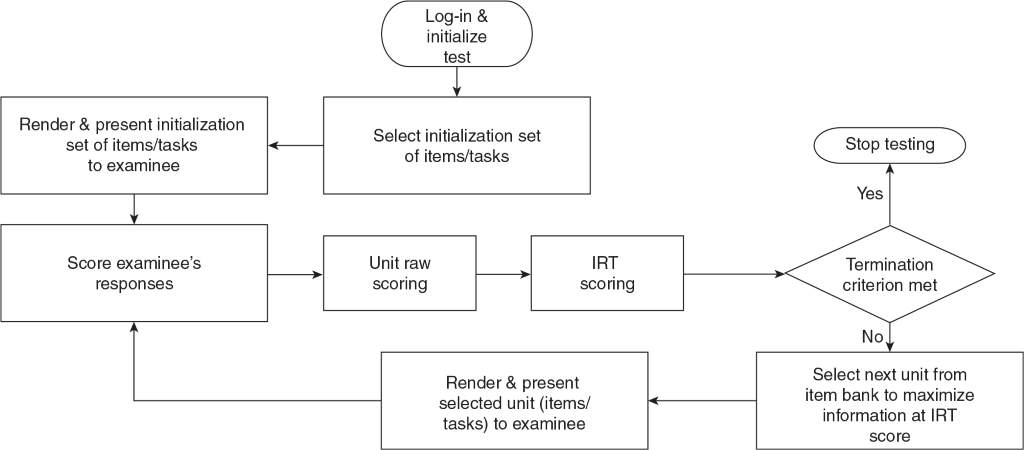Imagine sitting in front of a screen during a high-stakes exam like the GRE or GMAT. The questions shift based on your answers. You nail one, and the next gets tougher. Miss it, and things ease up. This dynamic setup defines adaptive admission tests. These exams adjust difficulty in real time to measure your true ability more accurately.
Experts design them to provide precise scores with fewer questions. For instance, research shows adaptive testing reduces test length by 50% to 90% while maintaining accuracy. A 2024 University of California study found it boosts exam scores by 35%. Students who master analysis techniques often outperform others. This guide walks you through practical steps to break down these questions. You’ll gain tools to boost confidence and results.
What Are Adaptive Admission Tests?
Adaptive admission tests change based on your performance. They use algorithms to select questions that match your skill level. Popular examples include the GMAT, GRE, and some SAT sections.
Test makers build these exams on item response theory. This framework evaluates how well questions distinguish abilities. As you answer correctly, the system picks harder items. Wrong answers lead to simpler ones. The goal centers on pinpointing your proficiency quickly.
Many universities rely on these tests for graduate admissions. They offer fairer assessments than fixed-format exams. Students face tailored challenges. This approach minimizes guessing and maximizes insight into strengths.
However, the adaptive nature adds pressure. You can’t skip ahead or review all questions easily. Understanding this mechanic helps you prepare better. Think of it as a conversation with the test. It probes your knowledge deeply.

Why Analyze Questions Effectively in Adaptive Tests?
Analysis sharpens your edge in adaptive environments. It lets you spot patterns and traps quickly. Strong analyzers adapt faster to rising difficulty.
First, effective analysis saves time. You identify key elements without rereading. This keeps pace steady. Moreover, it builds accuracy. Spotting subtle nuances prevents careless errors.
Research highlights the benefits. Studies show students who dissect questions thoroughly score higher. For example, adaptive tests reward deep understanding over rote memorization. You learn to think critically under pressure.
Additionally, analysis reveals your weaknesses. Track common mistakes during practice. Adjust strategies accordingly. Over time, this turns vulnerabilities into strengths.
Finally, it boosts mental resilience. Facing tough questions becomes routine. You stay calm and focused. Success follows from this mindset shift.
Step-by-Step Guide to Analyzing Adaptive Test Questions
Mastering analysis requires a structured approach. Follow these steps for every question. Practice them until they become second nature.
Start by reading the question fully. Absorb all details. Note keywords that signal the task. For instance, words like “infer” or “calculate” guide your focus.
Next, identify the core concept. Ask what the question tests. Is it vocabulary, logic, or math fundamentals? This frames your thinking.
Then, break down options if multiple-choice. Eliminate obvious wrongs first. Compare remaining choices against the stem.
After that, apply knowledge or formulas. Solve step by step. Verify each part for accuracy.
Finally, double-check your answer. Ensure it fits the adaptive context. Wrong picks might lead to easier paths, affecting scores.
Understand Different Question Types
Adaptive tests feature varied formats. Recognize them to analyze efficiently. Verbal sections often include reading comprehension, text completion, and sentence equivalence.
In reading comprehension, scan passages for main ideas. Look for supporting details. Questions test inference skills. Practice summarizing paragraphs quickly.
Text completion demands vocabulary and context clues. Fill blanks logically. Consider tone and structure.
Sentence equivalence requires synonyms that fit seamlessly. Select pairs creating similar meanings.
Quantitative sections cover problem-solving and data sufficiency. Analyze equations or graphs. Determine if data provides enough info.
Integrated reasoning blends verbal and quant. Evaluate tables or arguments. Spot trends and flaws.
Break Down the Question Stem
The stem holds the key to success. Parse it carefully. Highlight requirements and constraints.
For example, a math problem might specify units or conditions. Miss them, and errors creep in. Always restate the stem in your words. This clarifies intent.
Moreover, note any assumptions. Tests often embed tricks here. Challenge them if needed.
Transition to options only after grasping the stem. This prevents bias from answers.
Evaluate Answer Choices Critically
Choices can mislead. Scrutinize each one. Ask why it’s right or wrong.
Use process of elimination. Cross out extremes or irrelevants. Narrow to two or three.
Compare against the stem. Does it address the exact query? Partial matches often trap you.
In adaptive tests, wrong choices influence next questions. Accuracy here maintains difficulty curve.
Practice with timed sets. Build speed in evaluation. Over time, patterns emerge.
Apply Logical Reasoning
Logic underpins many questions. Use deduction and induction.
Deduce from given info. Infer unstated facts cautiously.
Spot fallacies in arguments. Common ones include ad hominem or false dichotomies.
In quant, apply theorems logically. Avoid plug-in methods if time-consuming.
Storytelling helps. Frame questions as real scenarios. This makes abstract concepts tangible.
Strategies for Verbal Sections in Adaptive Tests
Verbal questions test language mastery. Develop targeted strategies.
First, build vocabulary daily. Learn roots and synonyms. Use them in sentences.
During tests, read actively. Predict answers before options.
For comprehension, map passage structure. Note author views and evidence.
Handle tough vocabulary by context. Surrounding words offer clues.
Practice paraphrasing. Rewrite sentences simply. This aids understanding.
Moreover, time yourself. Allocate minutes per question type.
Adapt to increasing difficulty. Stay composed as texts complexify.
Tackle Reading Comprehension Effectively
Passages vary in length and topic. Skim first for overview.
Identify thesis and supporting points. Questions often target these.
Look for transitions like “however” or “therefore.” They signal shifts.
Answer detail questions by locating exact lines. Avoid overgeneralizing.
Inference questions require reading between lines. Base on text, not opinion.
Evaluate tone. Is it neutral or biased? This informs answers.
Practice with diverse topics. Science, humanities, social issues.
Master Text Completion and Sentence Equivalence
Blanks challenge word choice. Consider grammar and logic.
Try filling without options. Then match closest.
For equivalence, ensure both words fit identically.
Avoid common traps like antonyms or partial synonyms.
Review errors. Note missed contexts.
Build speed through drills. Aim for accuracy first.
Strategies for Quantitative Sections
Quant demands precision. Focus on fundamentals.
Review algebra, geometry, statistics. Know formulas cold.
Analyze problems for shortcuts. Estimation works sometimes.
In data sufficiency, assess each statement alone and together.
Avoid calculations if unnecessary. Logic suffices often.
Practice word problems. Translate to equations swiftly.
Handle graphs by labeling axes. Spot trends visually.
Adapt to harder questions. They test deeper concepts.
Solve Problem-Solving Questions
These require direct answers. Set up equations clearly.
Work step by step. Check units consistency.
Use backsolving for multiples. Plug in choices.
Estimate for large numbers. Narrow options.
Common pitfalls include misreading signs. Double-check.
Story examples: A runner’s speed problem. Define variables early.
Navigate Data Sufficiency
Unique format. Determine if info answers yes/no.
Statement one alone? Two alone? Combined?
Avoid assuming extra data. Stick to given.
Practice categorizing quickly. Saves time.
Errors often from overlooking combinations.
Integrated Reasoning and Analytical Writing
These sections blend skills. Analyze multi-source data.
For tables, sort and filter mentally.
Graphs: Compare variables.
Two-part analysis: Select matching pairs.
Arguments: Identify assumptions and flaws.
Writing: Structure essays logically. Support claims.
Practice integrating info. Time management key.
Common Pitfalls in Adaptive Test Analysis
Many fall into traps. Recognize them early.
Rushing leads to misreads. Slow down initially.
Overthinking simple questions wastes time.
Ignoring adaptive nature. Treat all equally important.
Guessing wildly. Educated guesses better.
Neglecting review. If allowed, use it.
Fatigue affects later sections. Pace yourself.
Practice uncovers personal pitfalls. Address them.
Practice Techniques for Mastery
Consistent practice builds analysis skills.
Use official mocks. Simulate real conditions.
Time sections. Track progress.
Review every answer. Understand why wrong.
Join study groups. Discuss analyses.
Apps offer adaptive drills. Use daily.
Vary difficulty. Push boundaries.
Track scores. Adjust focus areas.
Story: A student improved 100 points through targeted practice.
Tools and Resources for Analysis
Leverage free online platforms. Khan Academy for basics.
Books like official guides provide questions.
Forums discuss strategies.
Apps track vocabulary.
Software simulates adaptive tests.
Combine resources. Diversify learning.
Psychological Preparation for Adaptive Tests
Mindset matters. Visualize success.
Manage anxiety with breathing.
Build stamina through long sessions.
Positive self-talk boosts confidence.
Rest well before test day.
Adaptability comes from preparation.
Advanced Tips for High Scorers
Aim higher? Dive deeper.
Analyze question banks thematically.
Create custom drills.
Study error patterns statistically.
Seek coaching for nuances.
Experiment with strategies.
Refine timing per section.
Conclusion
Analyzing adaptive admission test questions demands structure and practice. You learned about test mechanics, step-by-step breakdowns, and section-specific strategies. Avoid common pitfalls and use effective practice methods. These tools enhance accuracy and confidence.
Apply them in your next session. Start today to see real improvements. Register for a practice test now and track your progress.
FAQs
What Makes Adaptive Tests Different from Traditional Ones?
Adaptive tests adjust difficulty based on answers. They provide precise measurements with fewer questions. Traditional tests use fixed items for all.
How Does Question Analysis Improve Scores?
It helps spot key elements quickly. You avoid traps and build accuracy. Consistent analysis leads to better adaptation in tests.
Can I Skip Questions in Adaptive Exams?
Most don’t allow skipping freely. Answer in order. Focus on current question to influence the next.
What Resources Help Practice Adaptive Analysis?
Official guides and mocks work best. Apps like Magoosh offer adaptive drills. Forums provide strategy discussions.
How Long Should I Practice Daily?
Aim for 1-2 hours. Focus on quality over quantity. Include review time.




